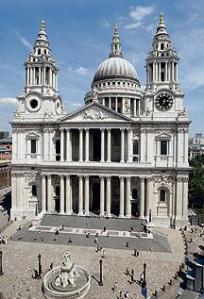Part IV, Part III, Part II 1/2, Part II, Part I
In past years we have been blessed to use Memorial Day as an occasion to visit the resting places or birthplaces of ancestors here in the UK and in the United States. Little did we know that our sightseeing visit to St. Paul’s Cathedral on this Memorial Day would become an opportunity to reflect on the life and death of my grandmother’s brother Glenn Brady who was an American airman stationed in the UK to fly sorties over Europe as a crew member of a B-17 “Flying Fortress” during World War II.
Glenn was born on January 30, 1921 in Fairview, Sanpete County, Utah and died one month shy of his 23rd birthday on December 20, 1943 when his bomber was shot down on a bombing raid over Bremen. As a staff sergeant and turret gunner in the crew of the B-17, Glenn had been stationed in Kimbolton, England as part of the 8th Air Force, 379th Bombardment Group, 527th Squadron. His fatal mission over Bremen in December 1943 was the crew’s sixth mission.
According to information obtained by German intelligence from at least three survivors who parachuted out of the crashing plane into enemy hands (records that were then given to U.S. officials after the war), the bomber had already dropped all its bombs and was heading back when it was shot down. The plane was apparently hit by attacking German fighter planes, and engines one and two on their B-17 caught fire.
Once hit and with two engines on fire, Glenn’s bomber was losing altitude rapidly, the plane filled with smoke, and they went into a spin. The centrifugal force made it difficult for those who made it to get out. They reported seeing Sergeant Brady pinned in the Ball Turret area. One said “Staff Sergeant Brady was standing on the seat of the Ball Turret trying to reach his chute as we were spinning down. I don’t believe he was successful”. Another said “He was firing at enemy aircraft in the rear of our ship”.
One witness said he saw the tail of the plane break away from the rest of the plane, and one account said he was pretty sure Sergeant Brady was in the tail when it broke away, and crashed to the ground. Another remembers he heard Sergeant Brady shouting at the Captain to bail out — and then shouting for everyone to bail out.
The German intelligence information names the German village of Westerbeck, just a little north of Osterholz-Scharmbeck, as the place of the crash. The documents also show that his body was interred at a “Cemetery of Army Post W.G., Section III, Field K, Row No. 1, Grave No. 3. on December 24, 1943″.
Glenn’s experience came to mind on this Memorial Day as we made our way past St. Paul’s holiest space, the High Altar, to spend a few moments in the apse contemplating the American Memorial Chapel and the significance of its placement at this location in the Cathedral right behind the High Altar. This was a part of the Cathedral that was destroyed in the German bombing of London during the war. When it was rebuilt in the 1950s, funds were donated by the British people to create the American Memorial Chapel, which has a dedication reading “To the American dead of the Second World War from the People of Britain” inscribed on the floor in front of it. As noted at the Cathedral’s website,The images that adorn its wood, metalwork and stained glass include depictions of the flora and fauna of North America and references to historical events.The three chapel windows date from 1960. They feature themes of service and sacrifice, while the insignia around the edges represent the American states and the US armed forces. The limewood panelling incorporates a rocket – a tribute to America’s achievements in space.
 The American Memorial Chapel houses a “Tablet” with a Roll of Honor containing the names of all Americans who died while en route to or stationed in the UK. The Tablet is a massive tome in a locked glass box with brass framing sitting on top of a waist-high marble pedestal with the following inscription in gold lettering on the front:
The American Memorial Chapel houses a “Tablet” with a Roll of Honor containing the names of all Americans who died while en route to or stationed in the UK. The Tablet is a massive tome in a locked glass box with brass framing sitting on top of a waist-high marble pedestal with the following inscription in gold lettering on the front:
THIS CHAPEL COMMEMORATES THE COMMON SACRIFICES OF THE BRITISH AND AMERICAN PEOPLES DURING THE SECOND WORLD WAR AND ESPECIALLY THOSE AMERICAN SERVICEMEN WHOSE NAMES ARE RECORDED IN ITS ROLL OF HONOUR THIS TABLET WAS UNVEILED BY H.M. QUEEN ELIZABETH II ON 26 NOVEMBER 1958 IN THE PRESENCE OF RICHARD M. NIXON THE VICE PRESIDENT OF THE UNITED STATES OF AMERICA
Glenn Brady’s name is listed in the Roll of Honor that is kept in the American Memorial Chapel. Unexpectedly, our visit to St. Paul’s Cathedral became a meaningful Memorial Day Commemoration as we contemplated this fitting tribute to an American airman who was put to rest in a cemetary behind enemy lines:
![]()
Continue reading at the original source →





